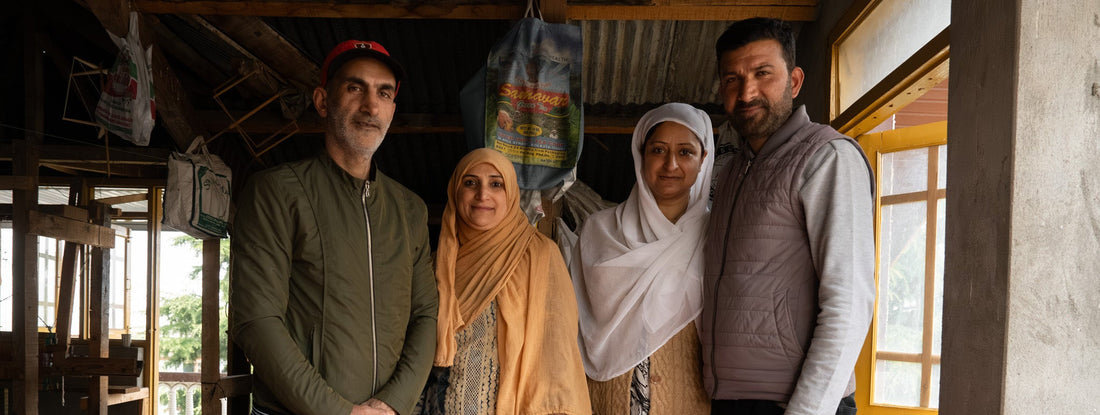
Ladakh’s cashmere tradition
Share
 A Changpa herder leads his pashmina goats across the high-altitude Changthang plateau of Ladakh.
A Changpa herder leads his pashmina goats across the high-altitude Changthang plateau of Ladakh.
The early morning sun casts long shadows on the frozen ground as a nomadic herder gently calls to his flock. In this remote corner of the Himalayas, Ladakh’s Changpa people have carried on an ancient ritual for centuries: tending Changthangi goats that grow the precious ultra-fine wool known as pashmina. Life here is harsh—the Changthang Plateau sits over 14,000 feet high with winter temperatures plummeting to minus 40°C—yet a unique harmony exists between the nomads, their animals, and the land.
Each spring, as the weather warms, the goats naturally shed their winter undercoat. The herders carefully comb out the soft fibers by hand (never shearing, to preserve its quality), gathering tufts of downy wool that will become some of the world’s finest cashmere. In this moment, tradition, nature, and patience converge – the first step in a journey from the windswept plateau to luxurious textiles treasured across the globe.
The Nomadic Craft of Pashmina in Ladakh
For the Changpa community, this wool is far more than a commodity; it is their lifeblood. Pashmina wool – often called “soft gold” – is the cornerstone of the Changpa economy The goats provide fiber, meat, and milk, sustaining families in one of the world’s most forbidding environments. Crucially, the extreme climate is exactly what makes Ladakhi cashmere so exceptional. Changthangi goats endure frigid alpine nights by growing an extraordinarily fine fleece under their coarse outer hair. Each animal yields only around 200–300 grams of pashmina wool per year—just a handful of fluff that must last until the next spring.
 An artisan weaves pashmina yarn on a traditional handloom.
An artisan weaves pashmina yarn on a traditional handloom.
Transforming raw pashm (unspun cashmere) into a finished shawl or scarf is an act of devotion and skill passed down through generations. First, the combed wool is painstakingly cleaned and hand-spun into an ultra-fine yarn – a task traditionally done by women of Ladakh and Kashmir using simple wooden spinning wheels or drop spindles. Then comes the art of weaving: on traditional handlooms, artisans interlace thousands of fragile threads, often incorporating subtle patterns or motifs. The result is a textile of exquisite beauty and unparalleled softness, imbued with the heritage of the Himalayas. It is little wonder that genuine pashmina products fetch high prices; they carry not just warmth and luxury, but the imprint of artisan hands and ancient knowledge.
An Unraveling Tradition
Despite pashmina’s global prestige, Ladakh’s nomadic communities have historically gained minimal benefit from their labor. Traditionally, the Changpa supplied raw pashmina, as Ladakh lacked facilities to process or weave wool locally. Even today, around 90% of Ladakh’s pashmina is exported as raw fiber, leaving local artisans and herders with only a small fraction of the final product’s value.

Industrialization and globalization have deepened these issues. Most global cashmere production now comes from large-scale operations in Mongolia and China, leaving Ladakh contributing only about 1%. Consequently, Ladakhi herders often sell their wool at minimal prices to corporate buyers, who integrate it into the international supply chain for substantial profit. Advocates highlight this exploitation, urging fairer conditions and equitable benefits for the original producers.
Threats to Livelihoods and Culture
Ladakh’s nomadic lifestyle faces severe challenges from cheap, factory-produced cashmere and counterfeit products flooding global markets. Fake "pashmina" scarves, machine-made from inferior materials, threaten traditional artisans' livelihoods, making it difficult for nomadic families to sustain their ancient craft. As a result, younger generations increasingly abandon traditional herding for city jobs, causing villages to empty and risking the permanent loss of Ladakh’s rich cultural heritage.

Yet, amidst these challenges, initiatives to protect this heritage are growing. Cooperatives and social enterprises have emerged, striving to retain the cashmere production value within Ladakh itself, directly benefiting local artisans and herders. This crucial movement inspired the creation of esho funi.
Guardians of an Ancestral Craft
Rooted deeply in respect for Ladakh’s heritage, works to preserve and celebrate traditional cashmere craftsmanship. Named after a philosophy symbolizing harmony between inner and outer worlds, the brand believes genuine luxury must uplift its origin communities. The brand directly engages with Changpa herders and local artisans, ensuring fair wages and sustainable practices.

The brand keeps the entire process local, empowering women artisans to handle cleaning, spinning, and weaving using ancestral techniques. Each esho funi product carries Ladakh’s cultural imprint—from the careful hand-spinning on drop spindles to weaving on traditional wooden looms. The commitment extends to using natural, eco-friendly materials and avoiding harmful synthetic processes, mirroring the Changpa ethos of sustainability.
Supporting a Living Heritage Through Ethical Luxury
Purchasing an esho funi cashmere product means actively preserving Ladakh’s heritage. Each accessory supports Changpa herders' dignified livelihoods, enabling families to invest in better livestock care and education. This ethical consumption provides artisans with meaningful employment, encouraging the next generation to carry on traditional practices.
Pieces symbolize more than luxury; they represent connections between conscious consumers and the nomadic communities of Ladakh. By choosing ethical cashmere, customers participate in a compassionate, sustainable fashion movement. Every purchase strengthens Ladakh’s cultural resilience, ensuring its timeless craftsmanship continues to thrive.